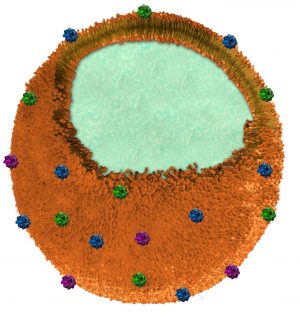by Josephin Vincent, Millersville University
If you were bitten by a snake, what would you do? Stay calm, yeah, that’s the first thing experts recommend. Next, it’s important to identify if the snake is venomous. If it is, you must quickly counteract the venom in your bloodstream. Venomous snakebites are usually treated with an antidote (neutralizes poison). But making antivenom isn’t easy, or quick, and often there is not enough for those who need it. Now, treatment with nanosponges could provide a whole new way of dealing with venom in your bloodstream–by soaking it up like a sponge.
Absorbing poisons in your blood
Nanosponges can remove dangerous substances from your blood system using things found in nature to design materials in the lab (biomimetics). Instead of using antidotes, nanosponges injected into your blood can soak up the toxins. In the bloodstream, the nanosponge mimics a red blood cell, tricks toxins into attacking it, and then absorbs it. The number of toxin molecules each nanosponge can absorb depends on the toxin.
To move through your blood, and avoid being attacked by your immune system, nanosponges are covered with a red blood cell membrane. One red blood cell membrane can make thousands of nanosponges that are about 3000 times smaller than a red blood cell. Nanosponges have a half-life (how long it takes for about half of the nanosponges to be cleared from your body) of about 40 hours. Eventually, both nanosponges and the toxins are safely metabolized (broken down or removed) without causing any damage to your body.
Researchers hope to develop this technology into approved therapies for snake and insect venoms, as well as bacterial infections. Even a bite from a non-venomous snake could become infected if not cared for properly. And, again, nanosponges could be used to absorb toxins from your infection.
Nanosponges for targeted delivery of medications
Nanosponges can be used to not only remove toxins from your blood–but also to deliver drugs. Think about a sponge soaking up water then squeezing the sponge to release the water. Instead of removing bad things from your bloodstream, nanosponges can be used to carry useful medications into specific parts of your body. For example, a medication can be released exactly where it is needed, like at the site of a tumor. Then, nanosponges can release the drugs without affecting your organs, tissues and cells not targeted for treatment. In this way, nanosponges can do amazing things–like delivering medicine for cancer safely and effectively.
This is a better method to deliver medication than through treatments that don’t target a particular organ. Because they are so porous, the nanosponges can carry more of the needed drugs than other “nanocarriers”–and, they can predictably release medication as needed. Targeted delivery is considered better for you because smaller amounts of the drugs are needed when they are targeted to just a small part of your body. It is hoped this will provide significant advancements in the treatment of cancer and other diseases.
Can nanotechnology change the world?
Nanotechnology has the potential to change the world in which you live. More uses for nanomaterials are being explored all the time. Nanosponges are being developed for a variety of purposes. Many of these are bio-inspired applications. Some can help people through healing techniques like delivering medication for diseases in just the right way. And, if you ever have the misfortune of being bitten by a snake, it may help you remain calm to know that nanosponges can save your life.
Resources:
Image Resources:
Image reference: http://jacobsschool.ucsd.edu/news/news_releases/release.sfe?id=1350
Image reference: http://www.nature.com/nnano/journal/v8/n5/images_article/nnano.2013.54-f1.jpg
Targeted Delivery of Meds
Image reference: http://1.bp.blogspot.com/_TZ4zYEBSw1I/TCu2fWiKKtI/AAAAAAAAMwo/kL8GtMYl5vk/s1600/nano_Nanosponge.jpg

